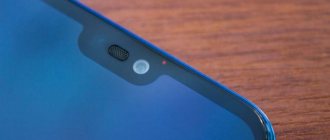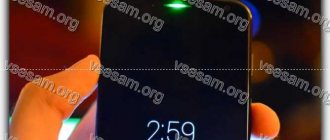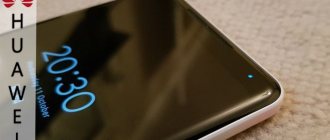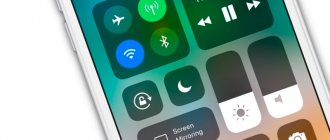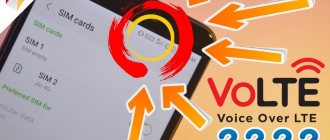Data encryption and integrated circuits
Such elements are installed on a board that controls the voltage supply.
The work is due to access to program code and the use of special microcontrollers. Using programming, timing is set, affecting the display of components at a certain time. The integrated circuit converts the binary and binary decimal code supplied to the display. Common circuits for controlling domestic indicators are K514ID2 or K176ID2, in imported models 74HC595. Control is possible in two ways: Directly, through microcontrollers; - Using shift registers
The first option is less successful due to the need to connect many pins. In addition, the current consumption may be higher than is possible with microcontrollers. Large seven-segment indicators depend on the MBI5026 chip.
Setting the indicator light color
Despite the fact that the color of the indicator is defined by default, you can customize it, that is, change it as you wish
.
Unfortunately, this function is not present in all phones in the line. More expensive, modern and functional models (for example, Xiaomi Redmi Note 4X
or
Xiaomi Redmi Note 5
) have the ability to make the indicator light acquire different colors in accordance with the user’s preferences. The color palette depends on the gadget model. How to change the color of the application indicator?
- Open “Settings” in any convenient way.
- Go to “All applications” in the “Applications” section.
We select any application for which we want to install a light indication and click on it.
Scroll through and find “Notifications”. Click.
Find “Indicator light”. Turn it on. If possible (in our case not), select the color for displaying notifications from this application.
To change the color of the indication of calls, messages and notifications from the device, you need to go to the “Indicator Light” section (again, it is not available on all models!) and under the functions of turning on the LED, select the desired color for each of the categories.
LED Control keywords
in the name and expand the capabilities of the gadget.
Smartphone Bluboo D1 - “state sector killer” with an original event indicator
Greetings, friends! Today we are reviewing a new product from Bluboo. The model is called D1 and is ready to offer customers a good design, a 5-inch display from Sharp, a dual rear camera, a fingerprint scanner, a metal back cover and an original event indicator. All this for $70-75 seems like a very good option, and the manufacturer calls this model a “state-sector killer,” but don’t rush, let’s figure out whether it’s really that good!? Below the cut is my opinion after two weeks of testing. I tried to honestly talk about the strengths and weaknesses of the device.
SPECIFICATIONS
• Quad-core MediaTek MT6580A processor operating at 1.3 GHz • 5-inch Sharp HD display, 2.5D G+F • 2 GB RAM, 16 GB internal memory expandable up to 256 GB.
• Main camera 8 MP + 2 MP from Sony, front camera 5 MP • Soft light effect for selfies, dual LED flash of the main camera • Indicator light • Metal body made of aviation aluminum alloy • Dual SIM (two micro SIM cards) • Fingerprint sensor on the back side • Android 7.0 Nougat • 2600 mAh battery • Color options: black, blue, gold More detailed technical specifications are described on the manufacturer’s website: bluboo.hk/product/bluboo-d1#3
PACKING AND EQUIPMENT
The Bluboo D1 smartphone comes in a white cardboard box with the logo class=”aligncenter” width=”800″ height=”600″[/img]
The back side shows the main technical characteristics of the device.
The delivery package could not be simpler: the smartphone itself, documents and a charger (5V, 1A) with a micro-USB cable.
DESIGN AND ERGONOMICS
The design of the smartphone is not bad at all: a metal body, beveled edges, thanks to which the Bluboo d1 fits perfectly in the hand. First impressions of the appearance of the $70 smartphone are very good. In addition, there are no complaints about the assembly, the body feels solid, there are no creaks or backlashes. Each part is clearly adjusted to other elements of the body.
On the front panel there are: light and proximity sensors, a speaker, a camera with flash, and touch control buttons.
But under the buttons there is an event indicator, a stripe along the body! I have never seen such an implementation anywhere before. In memory, only Meizu with a glowing circle... the rest made the event indicator simply an LED on the top of the front panel.
It looks original and beautiful. It can light up in different colors depending on the type of notification: missed call, message, etc.
The backlight can be different: green, blue, red, etc. Colors are customizable for each specific application or activity. You can also set it in the settings so that the indicator glows in three colors during music playback, light music, so to speak. Unfortunately, he will not blink in time with the music.
On the back panel there are: dual camera module, flash, fingerprint scanner. And at the bottom of the back cover there are slots for the speaker.
On the right side there is a power button and volume rockers
The left side is empty
On top there is a 3.5 mm jack for headphones and a micro-USB port for charging.
There is only one microphone at the bottom end
A 2600mAh battery is hidden under the cover.
There are also two slots for micro-SIM cards and a separate slot for memory cards up to 256 GB. A separate slot for memory cards is already becoming a rarity, but many people miss it so much.
Measured dimensions of the device: 141.5 * 71.8 * 9.25 mm
The weight is not the smallest, but still comfortable for using a smartphone.
DISPLAY
Bluboo D1 has a 5-inch diagonal screen from Sharp, HD resolution (1280 x 720 pixels). The picture has fairly saturated colors, correct white balance, and a good amount of brightness.
The screen resolution is of course low, but the graininess of the image is not visible; for a budget employee, the display is quite good.
In direct sunlight, the picture fades, but remains readable.
Viewing angles are close to maximum, although at certain angles (from the top of the display) the picture goes into bright colors.
But there is no oleophobic coating; water droplets spread across the glass.
The multi-touch test showed 2 touch points and this is a problem. However, this does not cause any difficulties when using it, two touches do not merge into one and you do not have to suffer when choosing one or another menu item. But it’s certainly time to switch to at least touchscreens with 5 simultaneous touches.
SOFTWARE PART
The Bluboo D1 smartphone runs on the Android 7.0 Nougat operating system. Android is almost pure, except for some features that manufacturers have added. We are talking mainly about the additional capabilities of the fingerprint scanner.
The smartphone also has a function to wake up with a double tap, launch applications using certain gestures without unlocking, and mute the sound by turning the smartphone screen down. All settings have been translated into Russian except for additional menu items from class=”aligncenter” width=”800″ height=”474″[/img]
There is a feature with which you can take “long” screenshots or screenshots of a specific part of the screen of any shape. At least in the shape of a heart, like in the video)
PERFORMANCE
The device is powered by a 4-core MediaTek MT6580A processor; this is an old 32-bit processor with a maximum frequency of 1,300 MHz. The Mali-400MP video accelerator is responsible for the graphics. In general, the performance is enough for the smartphone interface to work without lags or slowdowns. Minor slowdowns can only be encountered in the first 10 seconds after launching the Bluboo D1, then they disappear.
When the device starts, the user has access to: about 11 GB of permanent memory and about 1.1-1.2 GB of RAM.
The processor is old and clearly non-gaming, but you can still play World Of tanks Blitz and Asphalt 8 at minimum settings. Games like Real Racing and less powerful ones run without lag.
When playing for a long time, the smartphone heats up, very slightly, because there is nothing to heat up)) The temperature of the back cover was maximally heated to 35 degrees Celsius.
In the antitutu test, the smartphone showed expectedly modest results: 23,287 parrots.
3DMark test
CPU-Z test
Geekbench 4 test
RAM Benchmark
A1 SD Bench (RAM/ROM test)
WIRELESS TECHNOLOGY
I tested GPS using the GPS Test program, and also in the car using the Yandex Navigator application. The satellites are located in about 15 seconds. The number of satellites is small, only around 4-5.
The smartphone can be used as a navigator, there were no problems with determining the location, the satellites did not fall off while driving.
The Wi-Fi module works without problems, access points are found quickly, and the connection is stable. In the screenshots: the signal level through the wall and at a distance of two meters from the signal source.
Bluboo D1 only supports 2G and 3G networks, so unfortunately you won’t be able to use LTE with it... And so, GSM reception is stable, in transitions and areas with a weak signal (outside the city) it was possible to use the connection without problems. My interlocutors did not complain about the quality of my speech; I heard them just as well.
There are no questions regarding the operation of Bluetooth version 4.0. The smartphone finds other devices quite quickly. File transfer speed is standard for this technology.
CAMERAS
The smartphone has a dual rear camera, which allows you to take pictures with a supposed bokeh effect.
According to the manufacturer, the Bluboo D1 even has a matrix from Sony. Whether this is true or not is unknown, I can only say that the camera is the same budget as the phone. There is no bokeh effect (as stated on the official website) or wide angle. The main matrix has a resolution of 8 megapixels, the auxiliary (useless) one is 2 megapixels. Naturally, no normal background blur effect can be achieved; everything is done for advertising reasons. True, there is doubt that anyone else is willing to do this. The blur goes in a circle around the center of the image, sometimes the object is blurred, sometimes it’s not… That’s all the bokeh… Even in good lighting, I can’t say that the smartphone produces good quality photos. Only when adjusted for the cost of the phone can we say that the camera shoots more or less for its price range. There are obvious problems with the clarity of the picture at the edges of the frames, some colors are oversaturated, and the bright rays of the sun are blown out. In general, the Bluboo D1 is clearly not a budget camera phone and it’s clearly not worth buying because of the camera.
Sunny
The so-called bokeh effect is purely for show. The software blurs part of the image around the focus, but I can’t say that it looks beautiful. Although, however, something similar to blurring the background can be done under certain conditions and a series of failures.
bokeh
The manufacturer made a video comparison of the Bluboo D1 and Huawei Mate 9 cameras. The players are clearly of different weight categories, they are similar only in the back panel) In the video, the pictures seem to be quite good, but in real life everything is much worse...
In poor lighting, everything is expected to be even worse, a lot of noise and mediocre detail in the pictures. The dual flash works well; it can be used both as a flashlight and for taking pictures.
Late evening
Photos in original resolution can be downloaded from the link below: yadi.sk/d/zwqvfyR63KoBfX
The smartphone records video in 3gp format with HD resolution and a frequency of 30 fps. Due to the lack of any image stabilization, it is not worth shooting handheld, because The picture jumps around a lot. The quality is tolerable, the sound is recorded clearly. Suitable for household needs. Example video: yadi.sk/i/txjT2tdq3KoSfv
The front camera has a resolution of 2MP. There is a separate flash for selfie shots... I personally don’t really understand this) The quality is not so great anyway, but taking a selfie with such a camera in poor lighting and using a flash? However, it might be useful to someone... I've seen worse front-facing cameras, but at least on this one you can see something and it doesn't blur the pictures. As for the quality, there is no need to comment here, you can see for yourself.
Selfie camera
BATTERY
According to the manufacturer, the smartphone has a 2600 mah lithium-polymer battery.
It weighs 40 grams
\
The battery was charged with a current of 1A at a voltage of 5V
The tester showed 2293mah when charging from 0 to 100%. Full charging time was 2.5 hours.
The battery life of the smartphone is only enough for 5.5 hours of watching videos on YouTube or 4 hours of gaming. Videos and games kill the charge very quickly. If you use your smartphone only for calls, instant messengers and surfing the Internet, you will get a completely standard daylight hours. Those. The Bluboo d1 doesn’t have much autonomy, but it won’t be a disaster in terms of operating time for ordinary users who don’t use a smartphone for games.
SOUND
The smartphone's speaker is located on the back panel and produces quite loud sound, but not of high quality. A standard budget speaker, at maximum volume there is some wheezing when playing certain tracks.
The sound in headphones will also not please music lovers. The sound is typical for all budget devices... In principle, you can listen to music, but of course you shouldn’t expect any special quality of playback. But the smartphone has a radio)
FINGERPRINT SCANNER
The fingerprint scanner is located on the back of the smartphone under the cameras. It’s not difficult to feel it with your finger, because when you lean your finger against it, it rests against the block with the cameras. It is certainly more convenient when the scanner is located on the front panel, but even here it is quite comfortable to use. The response speed is low, but the accuracy is excellent. We have already learned how to make scanners) even in a state-owned vehicle there are no problems with operation, everything works stably.
OTHER
General video overview of the functionality
Disassembling the device
CONCLUSION
PROS:
- Good display (for a $70 smartphone) - Fingerprint scanner is stable, although not very fast - Metal body with good assembly - Separate slots for SIM cards / memory cards - Android 7.0 with additional features - Original event indicator
MINUSES:
— Mediocre cameras (the second one is for show) — The external speaker wheezes at maximum volume — 2-touch touch — Lack of 4G — No oleophobic coating
The Bluboo D1 smartphone belongs to the class of ultra-budget devices, so expectations for such a device are often low. You can turn a blind eye to many joints because of the price, but we won’t do this in order to understand whether it is competitive on the market.
For $70 you will get a well-built metal case and an original, nice event indicator. A cool indicator, of course, is not to say that it is a directly necessary thing; I think most people would be quite happy with a regular LED. However, no one else is experimenting with this now; it is much more important to insert two cameras on the back)) This smartphone has not gone far either: there is a dual camera module, but they haven’t taught how to photograph the D1. As a result, the bokeh effect is fake, and even without bokeh the pictures turn out so-so... The smartphone also cannot boast of autonomy. If you don’t play games and don’t watch videos on YouTube, then you will last a standard daylight hours. I think the old, non-energy efficient processor and poor optimization are to blame, maybe the situation will change with software updates. The screen from SHARP is quite good and will appeal to most users: the picture is juicy with the correct white balance and good viewing angles. The external speaker is so-so, wheezing at maximum volume. But there are no complaints about the quality of the conversation and signal reception, the GSM network receives well and you definitely won’t have any problems during conversations. The lack of 4G, which many are already installing even in ultra-budget devices, is disappointing.
Bluboo D1 "killer of budget employees"! The statement is loud, but this smartphone is unlikely to kill anyone outright) In some aspects, yes, but it will not be head and shoulders above any of its competitors as a whole, with the exception of some outstanding models of buggy phones)) If you look at what you can buy for a similar one amount of money, then the smartphone really doesn’t look that bad. Most competitors cannot offer a metal body, a display with normal color reproduction and an adequately functioning fingerprint scanner, but the D1 can boast of this.
Should I buy Bluboo D1? If the budget for purchasing a smartphone is limited, then this may be an option for purchase. Of the competitors for this amount, it will clearly be better than Doogee Shoot 2, which works sluggishly and the touch works as it pleases. Oukitel C5 Pro is not bad, but it has an indecently small battery. If you need 4G, the Bluboo Picasso 4G will do the job, but you won’t find any metal in the design, and there’s also no fingerprint scanner. I also remember the Umi Diamond X with a metal frame, but it is quite weighty, and the back cover is very impractical. As a result, I can say that the Bluboo D1 has the right to life, can compete with its rivals and become an objectively more attractive purchase for some people if they accept the disadvantages of the device.
In general, in this price segment there are actually a lot of options and it all depends on what you specifically need. If performance, support for 4G networks is not important and you do not plan to take artistic photographs, then this smartphone can be considered for purchase. If you have the opportunity to add another $30-35 on top, I would advise taking the Xiaomi Redmi 4x, it really is a budget killer. Still, no one can offer better smartphones than Xiaomi for around $100.
I tried to be objective and maybe I could help someone in choosing an inexpensive smartphone, I hope my work was not in vain) Thank you in advance for your likes and am ready to answer any questions that arise, I may have missed something. Until new reviews, friends!
The product was provided for writing a review by the store. The review was published in accordance with clause 18 of the Site Rules.
Method 1 using the Light Flow Lite program
Light Flow Lite is a free version of one of the most popular LED control applications.
In the free version, you can change the color of the LEDs for the most important functions of your phone, while the paid version supports up to 600 different tools.
After launching the application, a message about Light Flow permission will appear. You must allow the app to read your notifications - click Yes.
After returning to the main app screen, open to Notifications. There you will see a list of different events and applications that display the notification.
In the free version you can change the color of the LEDs, among other things:
- missed calls;
- incoming calls;
- unread SMS and MMS;
- Hangout notifications;
- calendar reminders"
- Email;
- low battery level.
After selecting the setting type, the notification will be divided into several tabs. You can enable/disable “Notification” and activate the screen backlight. There you will have several pre-made colors, as well as the ability to set your own color.
Circuit operation
I’ll briefly tell you about the purposes of the parts. Using R2 we adjust the input signal level. Through capacitor C1, the signal goes to the base of transistor VT1, which serves as an amplifier. Resistor R3 sets the bias to the base of the transistor. Then the amplified signal “comes” through capacitor C2 to diodes VD1 and VD2.
The negative signal goes to the minus, the positive signal to the 5th leg of the microcircuit. C3 and R4 serve as a filter. The higher the voltage on leg 5, the more LEDs light up. By the way, if you short pin 9 to positive, the LEDs will light up linearly. In the video you can see how this thing works.
Receive notifications when the screen is off
Let's say you have your phone lying on the table, or you just pulled it out of your pocket, and the screen is turned off.
What happens when you turn it on? It's a text message, a missed call, low battery, a new email, or a calendar reminder.
If you have an LED indicator, it will blink even when the screen is off, and you will know that your phone has something to say.
The Light Flow app allows you to set different LED colors for different notifications.
It can be yellow when you have a missed call, green light when you have a text message, blue light when you have a new email, and red light when the phone is low and needs to be charged.
You can control all types. Light Flow supports notifications from over 550 different apps.
What is an indicator light on a phone? Programming LED on the phone
New smartphones from Google: Nexus 5X and Nexus 6P are equipped with a notification light. This is a simple and convenient way to remind or warn you about unviewed ones.
However, this requires you to turn on a small blinking light before you can start using it.
How do you know if your phone has an indicator light so you can start using it?
To do this, you need to go to “Settings” and open the “Sound and notifications” section. If you see the “Indicator Light” parameter there and the “On” option opposite it, it means it’s there.
Once enabled, you can receive your phone's LED notifications in different colors depending on the type, even when the screen is off.
The Nexus 4, Galaxy S III and many Motorola, BlackBerry and HTC phones have such equipment.
Receive notifications when the screen is off
Let's say you have your phone lying on the table, or you just pulled it out of your pocket, and the screen is turned off.
What happens when you turn it on? It's a text message, a missed call, low battery, a new email, or a calendar reminder.
Is the notification indicator important to you?
Facebook Twitter VKontakte Google+
It happens that you communicate with other people and find out that some functions in a smartphone that are completely insignificant for you can be very important for someone else. One such feature is an indicator light.
I myself hardly pay attention to this function, there is an indicator - good, no - and God be with it. What is this connected with? The fact is that manufacturers have almost stopped installing high-quality large light indicators in smartphones; it’s just some kind of nightmare. Instead of a large, clearly visible “circle”, as was the case in the Samsung Galaxy S3, they install tiny, barely visible “dots” that you can barely see in the dark.
Another problem with the indicator light is how it reacts to all app notifications. It happens that some uninformative message has arrived, for example, information that applications from Google Play are ready for updating or have already been updated, but the indicator is still blinking. My smartphone is always next to my computer, so the constantly flashing LED is quite annoying.
Or let's take another example: you put the device on charge at night and go to bed. Of course, in a dark room the indicator will glow red or green! Of course, you can install the Flow application and try to configure its operation yourself, but, according to reviews from my friends, this program does not work correctly on all smartphones.
But my opinion is not shared by all users, for example, my friend, on the contrary, really appreciates the presence of the indicator, says that many notifications come in a day, he does not always record them, and when he sees a flashing diode, he immediately understands that there is a missed message or call.
What do you think about this small but important element in a smartphone? Is its presence critical or, on the contrary, do you try to turn it off whenever possible? By the way, among the interesting solutions regarding the indicator, I can cite the example of Umi IRON Pro, in which this element was moved down
What is a notification or battery indicator?
All Galaxy smartphones have a built-in LED display, and modern new products allow you to use a specific color for each event or application. So, during charging, the red light is on, and the green light indicates that the phone can be unplugged from the outlet. White, blue and purple LEDs notify the owner of new events:
- missed calls;
- received SMS to the number;
- new messages in instant messenger chats;
- new messages on social networks.
Light indication serves to draw users' attention to events that have occurred, without users needing to unlock the phone to detect new messages or missed calls. By setting up a smartphone, owners can turn off unnecessary displays or, conversely, use a convenient function for applications that are important in work and life.
How to Activate the Notification Light Using Always On Edge on Samsung Galaxy S10 Plus
Always on Edg
Step 2 When you open the app, you can see a list of settings from which you can select the notification LED you want.
note
It's important to remember that you need to grant the necessary permissions for the app to work. Step 3 Below you can see a list of alternatives with this in-app notification light
The list is quite broad, but the following can be highlighted:
Step 3 Below you can see a list of alternatives with this notification light in the app. The list is quite broad, but the following can be highlighted:
Put Led on camera or screen
With this option, you can choose whether the notification light will be around the screen or in the camera slot.
Change notification style
You can choose between different existing Led modalities, so the design style can be different
It is important to emphasize that the appearance can be changed in space or angles
Change LED notification color
This alternative is quite dynamic and fun since it allows us to choose the color of the LED lighting, here you can choose from a varied palette of colors to be able to customize up to 3 of these colors. With this tool you can edit and control the speed or thickness of edges.
Select when the LED will turn on
With this option we can decide when we want the indicator to be on, that is, we can choose, for example, not to show the indicator while the phone is charging or to only turn on when a notification is received. Even if we like it practical, we can set it to automatic mode so that it turns on the light when the device is locked.
With these two procedures, you can activate the notification LED all over the screen or around the camera notch of your Samsung Galaxy S10 Plus device.
What is LED indicator
Even with the simplest work in electrical circuits on the farm, a voltage indicator is useful - a device that shows the presence or absence of electric current and voltage in networks from to depending on the device. The expediency of its use is dictated primarily by the fact that the electric current cannot be seen with the eyes - its presence can only be judged by whether the device plugged into the outlet is working or not. The main function that the voltage indicator should perform is checking the integrity of the electrical circuit - this is what determines whether the device plugged into the outlet will work or not.
G4 LED notifications
Manufacturers often equip gadgets with an LED indicator - an LED that creates additional signals for notifications. Alas, it is impossible to associate the colors of this light bulb with the selected programs on most devices. But the situation can be easily changed using a third-party application. It allows you to associate different indicator colors with notifications from selected applications or even individual contacts. After closing the introductory tips, swipe the navigation bar from the left edge of the screen. After this, you will see a list of four types of events.
The first is From an outstanding notification - special notifications that, for example, contain the specified text or come from selected groups in instant messengers. The second type is For an installed application - notifications from specific applications. The third From system event, battery... - from system services. And the fourth type is Contact specific notifications - notifications from selected contacts.
Click on each event type in turn. Lists of programs, contacts and system services will appear on the screen. Mark those for which the indicator should respond with special colors.
Open it and customize the color, frequency, and duration of the notification light for notifications from each app, service, or contact you add here.
To do this, use the round colored icons. Using the adjacent icons, you can also customize the vibration type and notification sound. When you select any new event, the program will show video advertising. You can't skip it, but you can purchase the paid version of Light Flow Lite. It doesn't bother you with videos, it supports settings and some events that are not available in the free version. How to customize LED colors for different Android device notifications.
Get the best by email. Maxim Volotsky. Select the events to which the LED indicator will react. Having closed the introductory prompts, swipe out the navigation bar from the left edge of the screen. Download QR Code. Light Flow Legacy :Led Control. Developer: Reactle.
Light Flow - Light flow. Show more. Best of the week Views Comments. How to change your speech to sound more confident. How do the habits of rich and poor people differ? Where to go in November: 10 best destinations. What if there is war tomorrow? What to buy before the start of hostilities. Where to put unnecessary clothes if you don’t want to throw them away. How to lose weight in 10 minutes a day. Hell of an interval workout. Which Apple Watch to buy: comparison of characteristics of current models.
AliExpress and more: the most interesting finds of the day. The official Twitter app is back on Mac. How to remove dark circles under the eyes quickly and permanently. How to design the perfect room for a teenager. How to choose a franchise: advice from the founder of a coffee shop chain. Lifehacker on Telegram. Subscribe to the official Lifehacker channel. We write the initial correctly. Our big channel about shopping on Aliexpress. Men's items we found on AliExpress.
If you find an error, select the text and click. Copying materials is prohibited. The publication may receive a commission from purchases of products featured in publications. To synchronize your favorites and add comments. Login via Facebook. Sign in with Google. By logging in, you agree to the terms of the user agreement and the personal data processing policy.
Features of light indication in different Xiaomi models
As we noted above, the function of choosing different colors is not present in the entire model range of the brand. Budget options most often lack it and only have a white indicator for notifications and battery charging with the ability to turn it off. This, for example, is our faithful model for photo instructions Xiaomi Redmi 4X
and
Xiaomi Redmi 6
.
And models such as Xiaomi Redmi 5 Plus or Xiaomi Redmi 6 have a rich color palette. The notification indicator of Xiaomi Redmi 5 also has different colors, but there are slightly fewer of them.
Now you know what the indicator light is for and how to turn it on on different models of modern Xiaomi phones. We hope that our article was useful to you!
The instructions in this article are illustrated using Xiaomi Redmi 4X
Please note that on other devices other names of graphs and windows are possible (see text instructions)
This also explains the lack of choice of colors for display.
Most new smartphones and tablets have built-in LED lights that alert you to new notifications.
Only a few people know that the color can be changed and set unique for each notification.
Depending on the manufacturer, your Android phone may be equipped with options to control the LEDs.
In most cases, they allow you to do only basic management - disable or enable and configure basic parameters.
Luckily, there are several other ways to control LEDs, with the help of enthusiast apps.
In this guide, I will provide you with two options, or rather two applications - decide for yourself which one to choose.
What are LED indicators for? How to turn on the indicator light on Samsung phones
Not all Samsung phones, such as Galaxy a5, a3 2021, j5, j3, j7, a7, j2, a5 2021, j1, Ji 7 (not necessarily the a series) are equipped with a built-in indicator light function, but instead you can use a flash, which will notify you of an incoming call.
How to enable it depends more on the version of Android installed in them, for example, inclusion in 4.3, which is discussed below, differs from the new versions 5.0 or 6.0
If the indicator light is turned on, the phone will tell you about some events that happened to it.
To enable it, go to the menu and open settings. Then go to “My Device” and select the “Indicator” section.
I won’t describe how to set up the light indicator. There, just check the boxes next to the functions you need.
How to set up the notification indicator on Android through the engineering menu
| kak-nastroit-indikator-uvedomlenii-na-android-cherez-inzhenernoe-meniu.zip |
How do you turn on the indicator on 3? S decided not to turn on the notification LED. For a long time, W did not have a properly established notification system, and with the release of W 10.L Notification indicator for VK, S, V, WA, etc. In this manual, we will tell you how to set up and use the Notification Center in OS 7 on P. The topic has already been written here: turn off all the indicator notification checkboxes, reboot the phone, then turn on all the checkboxes and reboot again. SG J7 does not have a notification indicator on the front panel, only a photo flash on the back. How to set the indicator to. You cannot associate LED colors with notifications from specific applications on most devices. How to configure it flexibly. Here you can configure everything. Open on Android S Settings, then Accessibility, then Hearing and Flash Notification, to activate the function, tap the switch. When new notifications are received, the indicator starts blinking. By default the indicator reports. Only the most will be shown in the notification icons. Lights up only when the screen is on. There you can enable it and configure it
newslav.ru
How to turn on the indicator light on Honor and Huawei
Many users ask the question: how to turn on the indicator on Honor and Huawei? Step-by-step instructions will help you answer it:
- go to the general settings of your phone or tablet;
- We are looking for the “Applications and notifications” section;
- go down and open the status bar item;
- there will be a line “Blinking”;
- in it the slider must be switched to the active state.
How to enable/disable key sound on Honor and Huawei
If blinking is active, the slider will be highlighted in a bright color. If turned off, it glows dim gray.
Now, when receiving messages or missed calls, the LED sensor will blink green. If the phone is low, the device will indicate this in red. When power is connected, the orange sensor will light up.
Where is the notification indicator?
On some phones, like the Nexus One, it's in the trackball. In other phones, they are located under the glass in front of the top of the phone.
For more efficient color management, you can try Blink. With this application you can control the colors of SMS and MMS LEDs, the color of incoming/missed calls and several system notifications.
I find the LED indicator very useful. You have a phone with such a function - then quickly activate it, it is by no means secondary. Good luck.
Light Manager
The moment you receive an email or message, your phone will try to attract your attention using its built-in indicator. But by the flickering of the LED, you will never determine what exact event occurred, and you will still have to pick it up
Until you install Light Manager.
Light Manager is a program for Android that will help you configure the LED indicator of your gadget. With this application, you will teach it to react with different colors to certain events, for example, when a new message arrives on WhatsApp or an event from your calendar.
By default, the program already contains a number of settings for the most popular events. But you can delete signals that are irrelevant to you at any time and add what you need. To do this, simply touch the desired element and you will be taken to the notification settings menu. Here you can set the blinking frequency, select the color of the LED and immediately check the settings you have set in action.
If the program from which you want to receive notifications is not in the list, you can add it yourself. To do this, switch to the Light Manager alternative operating mode, and then select “Add application”. You will see a list of all programs installed on your smartphone. Select the app you want and add an LED notification for it.
Please note that Light Manager can report not only program events, but also various system events. For example, the application can notify you when the battery is low, there is no network signal, or quiet mode is turned on
It would also be a good idea to look into the advanced settings of the program, where you can set the frequency of the signal flickering, enable sleep mode (the time of day when Light Manager will not disturb you) and change the time for automatic shutdown of LED activity.
Setting up the LED indicator for notifications about various events
:
Developer: MC Koo
Platform: Android (Depends on the device) Interface language: Russian (RUS) Status: Full (Full version) Root: Not needed
Most new smartphones and tablets have built-in LED lights that indicate new notifications.
Only a few people know that the color can be changed and set unique for each notification.
Depending on the manufacturer, your Android phone may be equipped with options to control the LEDs.
In most cases, they allow you to do only basic management - disable or enable and configure basic parameters.
Luckily, there are several other ways to control LEDs, with the help of enthusiast apps.
In this guide, I will provide you with two options, or rather two applications - decide for yourself which one to choose.
Where is the indicator setting on Samsung?
You can configure the display or disable it for certain applications in the corresponding section of the Android settings. By sliding the switch, users can choose which events are “worthy” of attracting the attention of owners with colored flickering, and which programs should run “silently”.
If you don’t want to go into the settings, you can turn off LED notifications by tapping directly on the notification itself from the annoying application. This direct and short way allows you to instantly remove an unnecessary function for a specific program.
